
Sapphire X800 Pro
Written by John Yan on 6/4/2004 for
PC
More On:
Sapphire X800 Pro
What’s this? A Sapphire card without some funky name? Well that’s what we have here today. With the announcement of ATI’s X800 line, the video card wars are heating up again and today we take a look at the Sappphire X800 Pro. It’s the lesser card of the X800 series but it certainly performs like a top of the line card.

By now you’ve probably heard of the X800 line so we’ll do a brief rundown of the features. The X800 Pro is a 12 pipeline solution running at 475MHz at the core and 900MHZ DDR at the memory. Onboard are 256MB of Samsung GDDR3 RAM. New features over the 9800XT are…well… not too much. Here’s a comparison of the Radeon 9800XT and the Radeon X800 Pro along with the Radeon X800 PE card that we will be reviewing later.

Besides a few updates to Smartshader, Smoothvision, and Videoshader de-interlacing scheme, there aren’t really any new features. There’s no Pixel Shader 3.0 support like NVIDIA’s new card. More pipelines, faster clock speeds, and some tweaking is what the X800 series has over the 9800XT. For some that may come to be a disappointment. But most people are really concerned with speed and image quality and as long as it’s blazingly fast and looks good, that’s really the bottom line.
Physically the card from Sapphire is exactly like the ATI reference board and is pretty identical to the Radeon 9800XT. That’s going to change with Sapphire soon as they are introducing their Toxic line but until then this line from Sapphire will pretty much be very vanilla. It’s still a single slot solution with one molex connector and a large heatsink. The heatsink doesn’t take as much room on the X800 Pro as it does on the 9800XT card. If not for the different decal on the X800 Pro, you’d probably easily mistaken this card for the 9800XT.

The bundle that comes with the card is pretty sparse as Sapphire’s Redline software, PowerDVD, Tomb Raider: Angel of Darkness are the only things included. For connectors, the card now does include a component connector for those that want to plug the card into a high-def TV. The bundle, while lean, might be upgraded in future releases as they are releasing Prince of Persia: Sands of Time and Splinter Cell: Pandora Tomorrow in the Toxic line. There’s a chance the regular cards will also carry this bundle later on.
Testing on the card is done with Catalyst 4.5 drivers. We compare the X800 Pro to the Radeon 9800XT, both from Sapphire. Here’s the test setup:
AMD64 3200+
ABIT KV8-MAX3
2 - 256MB PC3200 Crucial RAM
Maxtor 120GIG 7200 RPM HD
Windows XP Service Pack 1
Catalyst 4.5

Our first benchmark is 3DMark 2001 SE and it’s one of two synthetic benchmarks we will use in this test.
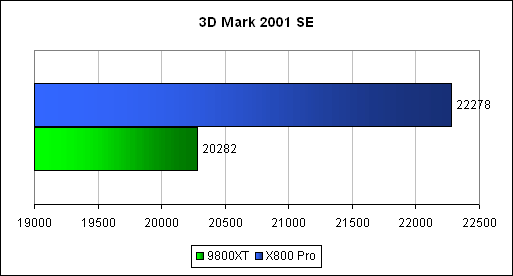
The test was done at 1024x768. The X800 Pro pulls ahead of the 9800XT with 2000 more 3D marks.

Aquamark is our final synthetic test that we ran with the two cards. Test was conducted at 1024x768.
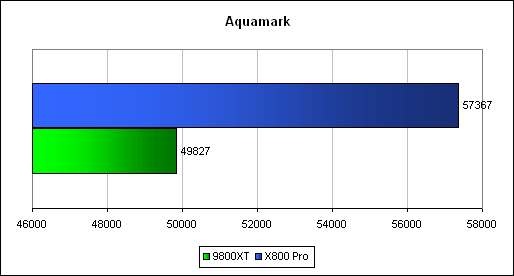
As you can see, the X800 Pro just blows away the 9800XT card in this test.
Let’s move on to some real world tests as we run through some games and compare a few anti-aliasing and anisotropic filtering settings also.

First up is good old Halo: Combat Evolved. The shooter from Microsoft was tested in three different resolutions with Pixel Shader 2.0 and using the default demo. Here are the results.
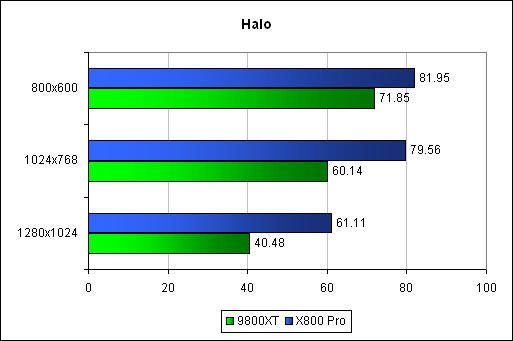
The X800 Pro averages 10 more frames per second at the 800x600 resolution and pulls ahead more as we up the resolution to more than 20 frames per second at 1280x1024.

Splinter Cell is our next test and in this one you can see a greater variant in scores between the two cards.
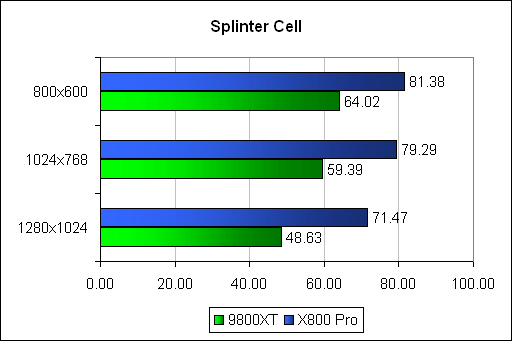
At lower resolutions, the X800 Pro scores well with 17 more frames per second. As we bump it up, the X800 Pro gets a slightly larger lead at a little more than 20 frames per second more.

Call of Duty makes its first appearance here in our test setup. The game was updated to the latest 1.4 patch and tests were run using the built in demo.
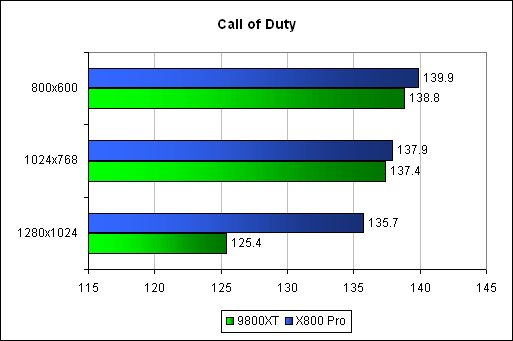
In lower resolutions, the game is CPU limited with the scores being close to identical. As we start to up the resolution the deviation becomes more apparent with a 10 fps jump from the 9800XT to the X800 Pro.

Unreal Tournament 2004 gets into the act as we phase out Unreal Tournament 2003. The two games are built upon similar technology though. Tests were taken with three demos of botmatches and then the three scores were averaged together. Details were turned to their highest levels.
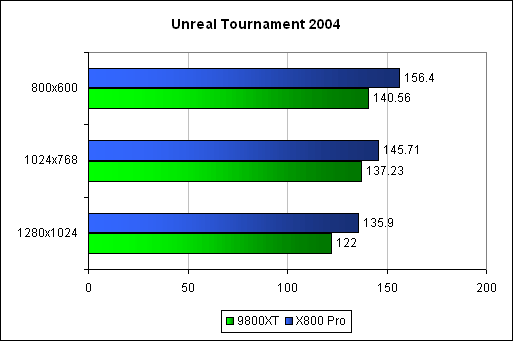
Double digit differences in the teens illustrate the difference in speeds between the two cards. We’ll get to see better how well the X800 Pro does over the 9800XT when we turn on the anti-aliasing and anisotropic filtering.

Finally, Far Cry is another new title we’ll start using the bench systems and cards. Details were set to maximum as we ran the tests. The demo used was the one included in the game.
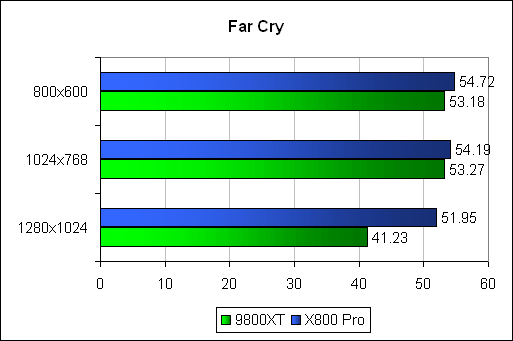
While the two cards stay close in the first two resolutions, the X800 Pro pulls ahead again as we increase the resolution.
Now that we’ve seen what it can do without any special features turned on, lets’ start upping the anti-aliasing and anisotropic filtering to see how it does in the various resolutions and how the X800 Pro compares to the 9800XT.
For a range of resolutions we started out with features turned off, then went to 4X anti-aliasing with 4X anisotropic filtering to 6X anti-aliasing and 16X anisotropic filtering. The three games we tested in this test were Call of Duty , Far Cry, and Unreal Tournament 2004.
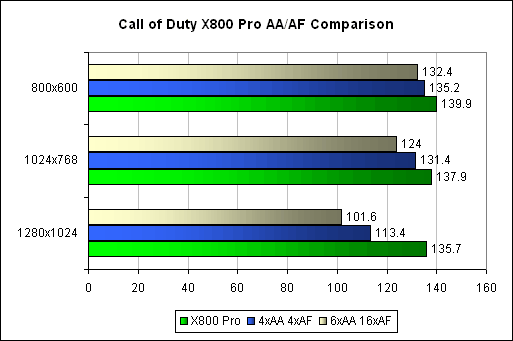
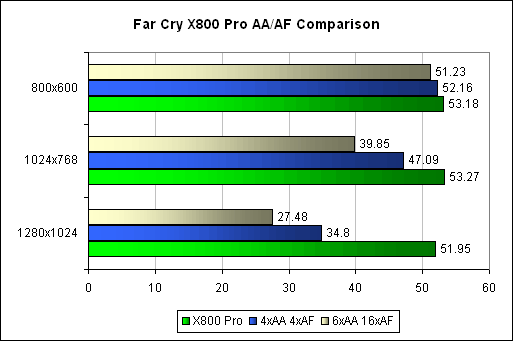
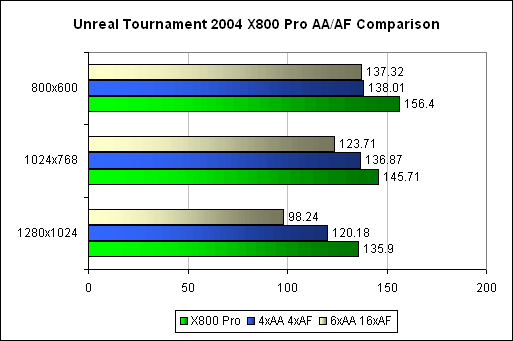
Call of Duty and Unreal Tournament 2004 still run very well with features turned to the maximum. In Far Cry, you can see a large performance loss as we increase the resolution and image enhancers.
So how does the X800 Pro’s performance loss compare to the 9800XT if we use it in the same system and turn on the features? Here are the graphs for Far Cry and Call of Duty.
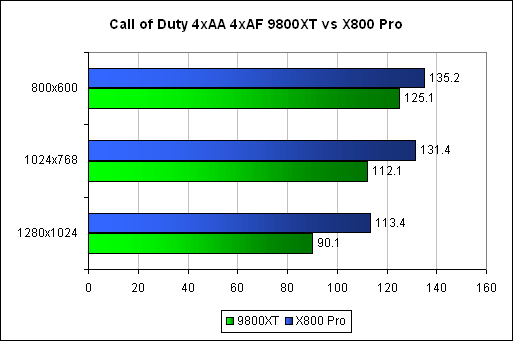
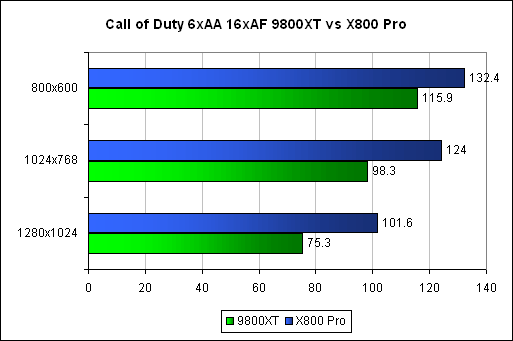
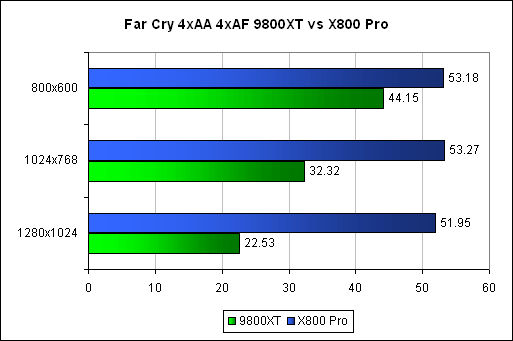
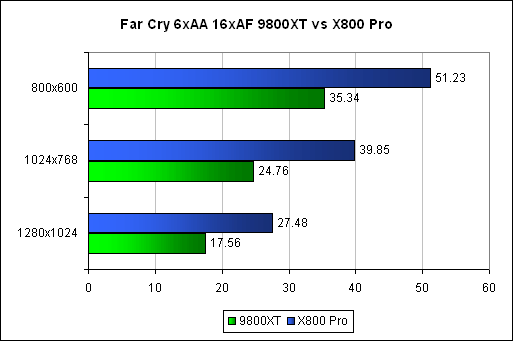
The X800 Pro certainly holds up a lot better as we increase the anti-aliasing and anisotropic filtering. In both games, the card does a good job at giving you great image quality and keeping up a good frame rate.
While there’s really no innovation over the ATI card (Toxic line coming soon though!), the Sapphire X800 Pro is a speed demon. You’ll have a better chance as of this writing to pick up this card than the NVIDIA comparable card. For those with a 9800XT already, there’s really no need to upgrade to the X800 Pro. Make no bones about it. With the price of the X800 Pro, it’s certainly an enthusiasts’ card. Sapphire’s products are generally priced less than the ATI version and I’ve always picked up the Sapphire edition over the ATI because of the fact that they are identical cards except for the price. We won’t know if the absence of Pixel Shader 3.0 will hurt this card for a while. While not a technological advancement, the X800 Pro does deliver in speed and it’s a one slot solution.

By now you’ve probably heard of the X800 line so we’ll do a brief rundown of the features. The X800 Pro is a 12 pipeline solution running at 475MHz at the core and 900MHZ DDR at the memory. Onboard are 256MB of Samsung GDDR3 RAM. New features over the 9800XT are…well… not too much. Here’s a comparison of the Radeon 9800XT and the Radeon X800 Pro along with the Radeon X800 PE card that we will be reviewing later.

Besides a few updates to Smartshader, Smoothvision, and Videoshader de-interlacing scheme, there aren’t really any new features. There’s no Pixel Shader 3.0 support like NVIDIA’s new card. More pipelines, faster clock speeds, and some tweaking is what the X800 series has over the 9800XT. For some that may come to be a disappointment. But most people are really concerned with speed and image quality and as long as it’s blazingly fast and looks good, that’s really the bottom line.
Physically the card from Sapphire is exactly like the ATI reference board and is pretty identical to the Radeon 9800XT. That’s going to change with Sapphire soon as they are introducing their Toxic line but until then this line from Sapphire will pretty much be very vanilla. It’s still a single slot solution with one molex connector and a large heatsink. The heatsink doesn’t take as much room on the X800 Pro as it does on the 9800XT card. If not for the different decal on the X800 Pro, you’d probably easily mistaken this card for the 9800XT.

The bundle that comes with the card is pretty sparse as Sapphire’s Redline software, PowerDVD, Tomb Raider: Angel of Darkness are the only things included. For connectors, the card now does include a component connector for those that want to plug the card into a high-def TV. The bundle, while lean, might be upgraded in future releases as they are releasing Prince of Persia: Sands of Time and Splinter Cell: Pandora Tomorrow in the Toxic line. There’s a chance the regular cards will also carry this bundle later on.
Testing on the card is done with Catalyst 4.5 drivers. We compare the X800 Pro to the Radeon 9800XT, both from Sapphire. Here’s the test setup:
AMD64 3200+
ABIT KV8-MAX3
2 - 256MB PC3200 Crucial RAM
Maxtor 120GIG 7200 RPM HD
Windows XP Service Pack 1
Catalyst 4.5

Our first benchmark is 3DMark 2001 SE and it’s one of two synthetic benchmarks we will use in this test.

The test was done at 1024x768. The X800 Pro pulls ahead of the 9800XT with 2000 more 3D marks.

Aquamark is our final synthetic test that we ran with the two cards. Test was conducted at 1024x768.

As you can see, the X800 Pro just blows away the 9800XT card in this test.
Let’s move on to some real world tests as we run through some games and compare a few anti-aliasing and anisotropic filtering settings also.

First up is good old Halo: Combat Evolved. The shooter from Microsoft was tested in three different resolutions with Pixel Shader 2.0 and using the default demo. Here are the results.

The X800 Pro averages 10 more frames per second at the 800x600 resolution and pulls ahead more as we up the resolution to more than 20 frames per second at 1280x1024.

Splinter Cell is our next test and in this one you can see a greater variant in scores between the two cards.

At lower resolutions, the X800 Pro scores well with 17 more frames per second. As we bump it up, the X800 Pro gets a slightly larger lead at a little more than 20 frames per second more.

Call of Duty makes its first appearance here in our test setup. The game was updated to the latest 1.4 patch and tests were run using the built in demo.

In lower resolutions, the game is CPU limited with the scores being close to identical. As we start to up the resolution the deviation becomes more apparent with a 10 fps jump from the 9800XT to the X800 Pro.

Unreal Tournament 2004 gets into the act as we phase out Unreal Tournament 2003. The two games are built upon similar technology though. Tests were taken with three demos of botmatches and then the three scores were averaged together. Details were turned to their highest levels.

Double digit differences in the teens illustrate the difference in speeds between the two cards. We’ll get to see better how well the X800 Pro does over the 9800XT when we turn on the anti-aliasing and anisotropic filtering.

Finally, Far Cry is another new title we’ll start using the bench systems and cards. Details were set to maximum as we ran the tests. The demo used was the one included in the game.

While the two cards stay close in the first two resolutions, the X800 Pro pulls ahead again as we increase the resolution.
Now that we’ve seen what it can do without any special features turned on, lets’ start upping the anti-aliasing and anisotropic filtering to see how it does in the various resolutions and how the X800 Pro compares to the 9800XT.
For a range of resolutions we started out with features turned off, then went to 4X anti-aliasing with 4X anisotropic filtering to 6X anti-aliasing and 16X anisotropic filtering. The three games we tested in this test were Call of Duty , Far Cry, and Unreal Tournament 2004.



Call of Duty and Unreal Tournament 2004 still run very well with features turned to the maximum. In Far Cry, you can see a large performance loss as we increase the resolution and image enhancers.
So how does the X800 Pro’s performance loss compare to the 9800XT if we use it in the same system and turn on the features? Here are the graphs for Far Cry and Call of Duty.




The X800 Pro certainly holds up a lot better as we increase the anti-aliasing and anisotropic filtering. In both games, the card does a good job at giving you great image quality and keeping up a good frame rate.
While there’s really no innovation over the ATI card (Toxic line coming soon though!), the Sapphire X800 Pro is a speed demon. You’ll have a better chance as of this writing to pick up this card than the NVIDIA comparable card. For those with a 9800XT already, there’s really no need to upgrade to the X800 Pro. Make no bones about it. With the price of the X800 Pro, it’s certainly an enthusiasts’ card. Sapphire’s products are generally priced less than the ATI version and I’ve always picked up the Sapphire edition over the ATI because of the fact that they are identical cards except for the price. We won’t know if the absence of Pixel Shader 3.0 will hurt this card for a while. While not a technological advancement, the X800 Pro does deliver in speed and it’s a one slot solution.
A card that costs about $40 more than the 9800XT, the X800 Pro's not a cheap buy but gives you plenty of horsepower for games. No PS 3.0 support and not that innovative over the 9800XT, the X800 Pro still delivers the speed that gamers want.
Rating: 8.8 Class Leading
* The product in this article was sent to us by the developer/company.

About Author
I've been reviewing products since 1997 and started out at Gaming Nexus. As one of the original writers, I was tapped to do action games and hardware. Nowadays, I work with a great group of folks on here to bring to you news and reviews on all things PC and consoles.
As for what I enjoy, I love action and survival games. I'm more of a PC gamer now than I used to be, but still enjoy the occasional console fair. Lately, I've been really playing a ton of retro games after building an arcade cabinet for myself and the kids. There's some old games I love to revisit and the cabinet really does a great job at bringing back that nostalgic feeling of going to the arcade.
View Profile